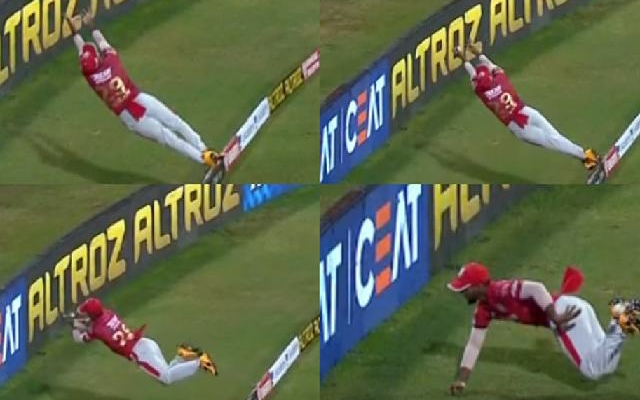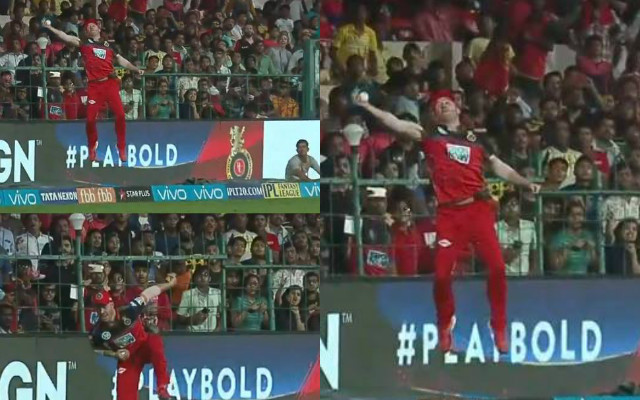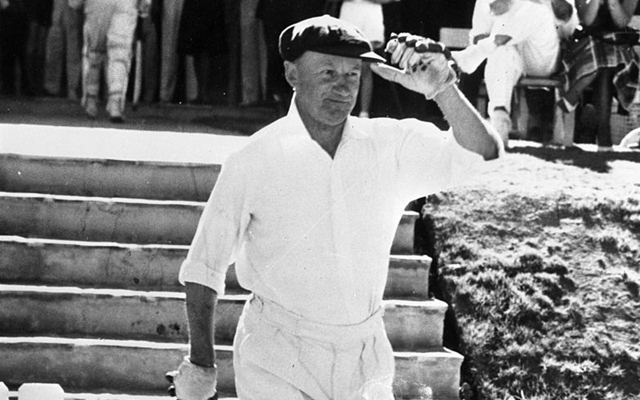Nicholas Pooran’s six-saver made an emphatic statement about modern-day cricket: Fielding is not art now but an industry
Did Sir Don Bradman ever field like this player in the IPL or faced a fielding like this? -- is the question that pops up.
2 Min Read


“Gravity-defying” is a term which is heard not too irregularly nowadays in cricket. The recent spectacle of Nicholas Pooran who suspended himself in the air like a bird to save a six during an IPL match in Sharjah was another such occasion in the list. The 24-year-old Caribbean’s effort stumped everyone on and off the field and made the great Sachin Tendulkar to concede that it was the best save he has witnessed in his life.
These spectacles are a treat for the eyes. Such logic-defying actions make T20 cricket’s popularity ever-soaring. Nobody knows till a ball crosses the rope, even if in flying mode, that it will clear the fences. This exciting uncertainty and the visual pleasure take cricket to the pinnacle of greatness in a flash.
To all the puritans who believe that it is the advent of the shortest variant of the game that has ruined the sport’s future and with all the scandals and money-making making it look like a shoddy business, there is one big contribution that T20 has made to the game and it is the improvement in fielding standards.

Traditionalists may still disagree but the fact is fielding in cricket has changed so much from their era across the formats (even including Tests), thanks to the T20s, that they perhaps have no fair idea about how and when the course changed forever. They may argue that the grounds are smaller in T20 games and shortcoming in fielding skills get exposed when matches are played on bigger grounds. They also feel that since the bowlers have a little say in T20 games, the fielders as their support also find their roles diminished.
But these arguments have not survived the test of time. The best strategy for anybody who has been cornered is to retaliate and the same has happened with the fielders in T20 cricket. The bowlers still have the red eyes of the human and robotic umpires scrutinising them to restrict their capacities but for the fielders, the sky’s the limit and Pooran-like efforts make it amply evident.
If batters have a free will today, the fielders too have wings

In T20 cricket where batters are given a run, fielders have come up with a counter-narrative. They give the fielding captain an added support to fall back upon. The eternally green sight of Jonty Rhodes dashing towards and crashing into the stumps to dismiss Inzamam-ul-Haq in a World Cup match in Australia in 1992 is no more rare and generations of fielders since the South African have chased the dream and accomplished it too. Rhodes was a pioneer who made fielding in modern-day cricket an art that was often overlooked but times have changed so much now that fielding has evolved into an entertainment industry in itself.
Vastly improved fitness has made fielding a top skill
Improvements in physical conditioning and fitness standards of today’s players have also played a big role in raising the fielding standards. Earlier, those fielders who prowled like predators on the ground were more seen as God-gifted talents and it was believed that not all could imitate them. But the support system of cricketers has come of age in such a way that those ‘God-gifted’ talents have now become more of ‘factory-produced’ robots.
A captain now doesn’t look for his one or two top fielders to man key positions in the ground. Any fielder can take care of any position: Generalists are the new specialists. The power, agility and flexibility have become something that could not have even thought of in the age of amateurs or semi-amateurs. If to field like Jonty Rhodes was something extraordinary those days (remember ‘Jonty’ became synonymous with good fielding, ask Mr Siddhu), to not be like him or ever closer is seen as something unusual in today’s times.
Did Don Bradman face today’s fielding?

Contemporary cricket often finds a major allegation against it and that is about it winning an ‘unfair’ comparison with the old days. “Did that batsman face the West Indies bowlers?” or “Have that bowler met somebody like Vivian Richards?” are questions that are often asked when any modern-day player, especially a batsman, betters the records of a player of the yesteryears.
But in the realm of fielding, the reverse is more true. Did Sir Don Bradman ever field like this player in the IPL or faced a fielding like this? — is the question that pops up. Could his average be around 100 had there been today’s fielding standards in his times? This is an undeniable change that today’s cricket has seen and perhaps its biggest as well.
A sea-change in the support system has also made today’s fielders more daring. With the improvements in medical facilities, the recovery time is faster and that makes fielders less hesitant to showcase their skills on the ground. The playing surfaces have also improved over the years which is visible from the fact that the players of the subcontinent dive more readily than what they used to do a couple of decades back.
To be a good fielder is also a top requirement from cricketers nowadays, just like those IT professionals who need to know the latest skills in the industry. It is no surprise that T20 fielding has come under the scanner of mathematical research (https://people.math.sfu.ca/~tim/papers/fielding.pdf) because they are setting up a benchmark for the sports and its practitioners.
Download Our App